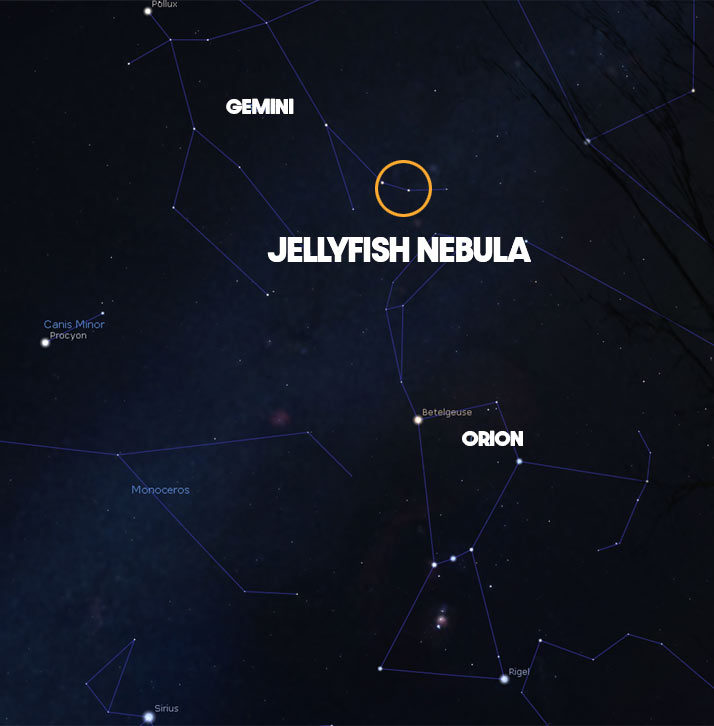Astrophotography: The Jellyfish Nebula
The Jellyfish Nebula (IC 443) is a supernova remnant located in the constellation Gemini. This nebula is approximately 5000 light-years from Earth and is estimated to be roughly 70 light-years in size.
In the wide-field telescopic view below, you’ll notice two bright stars, Tejat, and Propus (Tejat Prior). The locate the Jellyfish Nebula with your telescope, use these two bright stars as a guide.
This image was captured from my light-polluted backyard using a dedicated astronomy camera, and a small refractor telescope. The image includes 2.6 hours of total integrated exposure time.
The night I photographed the Jellyfish Nebula was not totally clear. High clouds interrupted my astrophotography session, but I continued to take pictures anyway.
Photo Details:
- Total Exposure: 2.6 hours (39 x 4-minutes)
- Camera: QHY268C
- Filter: Radian Triad Ultra
- Telescope: Radian Raptor 61
- Mount: Sky-Watcher EQ6-R Pro
Here is a look at the astrophotography telescope used to photograph the Jellyfish Nebula. This telescope has a focal length of 275mm, which allowed me to capture IC 443, and nearby Sharpless 249 in a single frame.
The camera and telescope used for my photo of the Jellyfish Nebula.
Jellyfish Nebula
NASA’s Chandra X-ray observatory has revealed that the explosion that created the Jellyfish Nebula may have also formed a rapidly spinning neutron star or pulsar on the southern edge of the remnant.
NASA’s latest research estimates the age of this supernova remnant to be tens of thousands of years, which aligns with previous work that estimated IC 443 to be about 30,000 years old. IC 443’s true age remains in question, as other scientists have inferred much younger ages of about 3,000 years.
Related Article: What Spawned the Jellyfish Nebula?
- Cataloged: IC 443, Sharpless 248
- Common Name: The Jellyfish Nebula
- Object Type: Supernova Remnant
- Constellation: Gemini
- Distance to Earth: 5,000 light-years
The Jellyfish Nebula is located next to the bright star Propus (Tejat Prior) in the constellation Gemini (Stellarium).
When is the Best Time to see the Jellyfish Nebula?
At mid-northern latitudes, the best time to see and photograph the Jellyfish Nebula is from November to March. From my latitude (43 degrees north), this nebula rises high into the sky above Orion.
The high apparent altitude in the sky means that the object is well away from the light dome of the city, and benefits from less turbulence in the air.
By late March, IC 443 begins to set in the western sky soon after midnight.
The Jellyfish Nebula is difficult to observe through a telescope. An OIII filter and dark skies are recommended to help find this supernova remnant in the night sky visually.
Through long-exposure photography, much more of the Nebula can be revealed.
Starless Image
Astrophotographers often “remove” the stars from an astrophoto to highlight the structure of their deep-sky object. StarNet++ is a simple and convenient way to automatically remove the stars from your image and can be used as a stand-alone tool, or inside of PixInsight.
Although it creates an unnatural-looking image, it can be an effective way of showcasing an intricate nebula like IC 443. Below is a photo of the Jellyfish Nebula with the stars removed via StarNet++.
IC 443, The Jellyfish Nebula.



